After my gun barrel split open I had a reader request that I send the barrel to him for analysis. This is what I know so far:
May 21, 2015:
I cut the end off the barrel to expose the fracture surfaces. I see no evidence of fatigue at the macroscopic level, the barrel will have to go under the microscope. I took the intact muzzle section and put it under the hardness tester. KKM advertises their barrels as being heat treated to 45 HRC. I measured an average value of 42 HRC with a minimum value of 40.9 HRC. Heat treatments on small parts are generally +/- 3 HRC meaning a barrel in spec will range between 42 and 48 HRC. I would state at this point that this barrel was in spec for heat treatment, but just barely and on the low end. Of course I will send the data out to my senior engineer for review. He was the chief metallurgist for Remington and I’ll get his opinion on the heat treat spec.
June 4, 2015:
I put the fracture surfaces of your barrel under the microscope today, as well as having the chemistry done. The chemistry was within specifications, but the manganese to sulfur ratio was low. What I saw the was most interesting was a crack at a 45deg angle coming down from the front of the first locking lug into the barrel, almost 1/4 of the way through the thickness of the barrel. This crack looks to have been formed during the repeated firing/cycling of the gun and caused the barrel to rupture in front of the chamber and at the 12 o’clock position. As the top surface of the barrel came free, this imparted a bending moment on the opposite side of the barrel and caused it to split at the 6 o’clock position.
I am frankly amazed at this failure. I have never seen shear fatigue in a gun barrel before. I’m going to send this off to my firearms expert, he’ll find this interesting.
June 8, 2015:
LHS is “left hand side” and RHS is right hand side (breach towards you, muzzle away, in the as-assembled orientation), the barrel having been split in half along the major fracture surfaces. As you can see there is a crack at about 45 deg from the front of the first locking lug going in the muzzle to chamber direction. It goes about a quarter of the way though the thickness of the barrel. I am having the barrel cut by our machinist to expose that crack fracture surface to look for evidence of fatigue.
The color pics are optical microscopy, the black and white are scanning electron microscopy (SEM).
He sent me 18 pictures. I’m posting the more interesting ones:


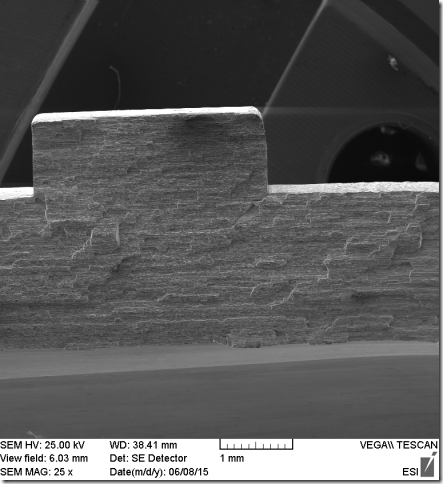
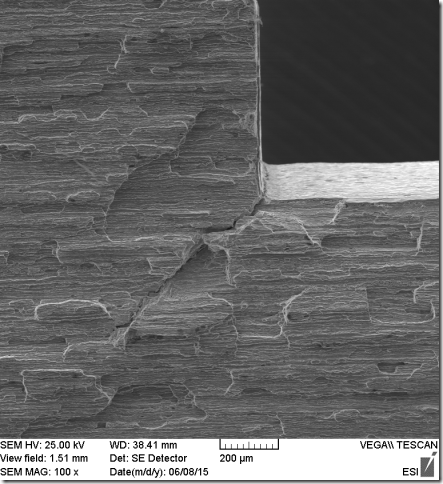
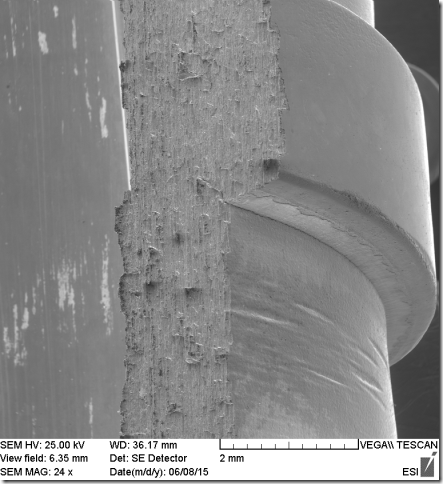

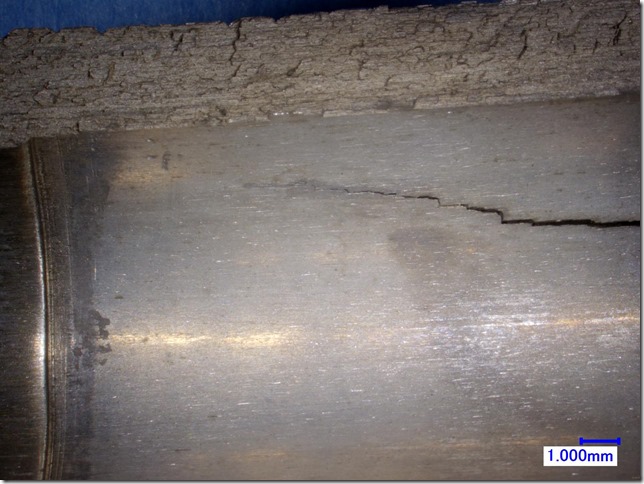
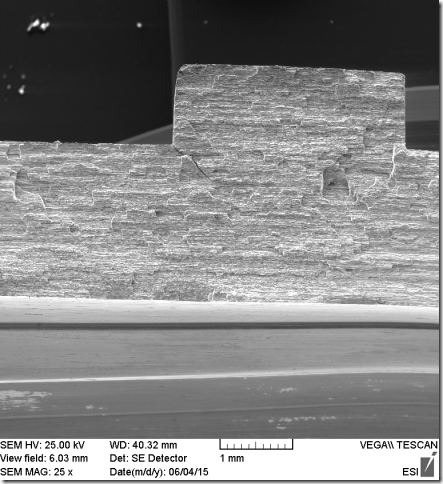
excessive pressure. if it is not fatigue induced, what else is there?
interesting internal grain structure on the barrel steel. not that i’ve seen a whole lot of this kind of stuff, i am most definitely not a metallurgist. but, i’ve never seen grain that layered in large scales like that.
maybe it’s common, i don’t know. just outside my limited experience.
It was not excessive pressure. See the cartridge in the chamber when the barrel split.
And the metallurgist explicitly said it was due to a crack propagating from the front of the first locking lug. He goes on to say, “This crack looks to have been formed during the repeated firing/cycling of the gun.” It had nothing to do with excessive pressure.
Soooo….? Timing or fitting wrong so that it was battering on one point improperly, rather than the whole surface? Or….?
Any time I hear “sulfur” and “steel” I think “titanic” and “brittle,” though that may not be fair to the metallurgist of the day.
I agree the grain looks odd (and that I’m not a metallurgist), and that the pictures are cool.
The LH003 strikes me s very odd. How’d they cut the barrel?
I find that 45 degree crack as interesting as he does. From the location that indicates torsional stresses on the barrel, something I can’t imagine seeing given cycling action of the weapon being front to rear only…..
If we look at recoil as being against the breech face (the slide) then the slide is pushing the barrel to the rear under force of recoil;
“…there is a crack at about 45 deg from the front of the first locking lug going in the muzzle to chamber direction.”
Friction between case and chamber wall will take up some of that force, but not a major portion I wouldn’t think.
During the forward stroke, the barrel’s inertia is checked by the slide, again pushing the barrel lugs toward the breech.
As stated herein elsewhere, it may be too that the one lug was bearing a disproportionate amount of the forces. Close inspection of the slide-to-barrel lug fit, and the lug interface surfaces of both the barrel and the slide, might reveal something there.
I don’t see anything odd at all then, so far, given the apparently compromised condition of the steel, but maybe I’m mis-reading something.
That actually makes a lot of sense. I didn’t consider the shear forces involved in locking the barrel to the slide via the lugs
Incidentally can you tell why I got Cs in aerospace structures all those years ago? :p
This is mostly my stream of consciousness trying to envision what is happening. Correct me if you see something in error…
The bullet is accelerating (ignoring the gas jet out the muzzle and later the chamber) it is increasing momentum in the forward direction. There must be a corresponding increase of momentum in the opposite direction which is transmitted through the barrel to the slide. Conservation of momentum requires this.
On the return to battery phase the recoil spring is pushing the slide forward from the muzzle end. It is pushing against the frame at the point where the link attaches to the frame. The breach face will strip a round off the top of the magazine and push it into the barrel. As the round is chambered the case mouth makes contact with bottom of the barrel chamber and pushes the barrel forward. As the barrel moves forward the link will rotate and push the barrel upward which will cause it to engage the locking lugs.
The barrel is slowed and stopped by the link! If the barrel were not present the slide would fall of the forward end of the frame. Right?
Therefore the SLIDE is stopped by the BARREL, not the other way around. The points of action are breach face (through the case) and the locking lugs. Right?
So how did we get a crack developing on the forward edge of the locking lug? Could it be the barrel was stretching due to pressure in the chamber but being constrained by the locking lugs and the breach face?
Gun barrel steel is generally a resulfurized steel, also known as a free machining steel. The sulfur is bound up with manganese as manganese sulfide, which when properly processed forms little inclusions distributed through the microstructure. In machining, these inclusions are weak spots that allow for easy chip breakage and improve machine-ability.
In gun barrels the combination of heat treatment and rolling causes these inclusions to line up in a microstructural condition known as stringers. This is done on purpose. The idea is, that if the barrel ruptures, it splits lengthwise along these stringers instead of coming apart into little pieces.
This was first done in WWII by British artillery piece makers. It was discovered that by using a free machining steel with a longitudinal rolling direction, if the barrel ruptured from over heating during a high volume of fire, the barrel would split open and deform instead of exploding into shrapnel and killing the crew.
I saw no evidence of over pressure. I did some more SEM work and will more results tomorrow.
Very cool. Several things in that post I didn’t know.
Thanks.
This is actually very fascinating. Thank you for taking the time with this. I love reading failure analysis stuff.
The bottom corners of the lug slots look to have insufficient radius for stress relief. Too sharp a corner can lead to fractures. This was a common problem, a few decades ago, when having crankshaft journals reground to fit the next size bearing. Machinists would use tooling with too sharp a corner tip, thus leaving a 90 degree angle with no radius. Looks nice, but fractures under normal operating stresses.
I suspect that that sharp a corner might not have been a problem with a .45acp, but the .40s&w is a lot higher pressure, and probably a quicker rise to peak, so more smack to that shoulder face. I wonder if that was the only shoulder in contact?
The first barrel failure was of the lugs on the bottom of the barrel the link attach to. Not the locking lugs on the top of the barrel like this one.
This barrel had the link break a few years ago.
I do suspect there has either been something wrong with the slide or the fitting of the barrels to the gun.
Joe,
Let me start over, and tie it all together.
Having just finished a degree in mechanical engineering, I admit that I am junior in my complete understanding of mechanics, but my theoretical knowledge is backed by gunsmithing experience on the particular firearm action in question, including study of many other delayed blowback, recoil-operated firearms. I admit that I may be incorrect in my analysis, but I highly doubt it. I am not trying to brag or be “holier-than-thou” by telling all this, but simply explaining that I have a very good grasp of what’s going on here, and that I’m not simply pulling this out of thin air.
Before ignition, the slide is pushed forward, away from the frame, from the force of the action spring. The barrel is pushed forward by the cartridge case mouth, where the case is crimped, during the return to battery. The barrel hood does not contact the breechface. The only part or parts of the barrel that are in contact with the slide at this point are the muzzle (if it’s a bushingless gun) and (maybe) the barrel locking lugs.
When ignition happens, pressure builds extremely quickly. It also tapers off extremely quickly, dropping to a small (relatively) amount by the time the bullet reaches the muzzle. In most rifle cartridges, that pressure is under 500 psi at the end of a 20″ barrel. They start at much higher pressures than the .45 ACP and the .40 S&W, so if we’re conjecturing a little bit, we can assume that the pressure will be within an order of magnitude of that value, likely under 1000 psi considering the very small gas volume. The case is forced immediately against the breech face and the bullet heads toward the rifling as the gas expands. The case also expands nearly instantaneously, sealing the chamber and barrel to the rear.
As the bullet travels forward, it engraves into the rifling. At this point, the bullet starts dragging the barrel forward with it due to the extremely high amount of force required to overcome the friction between the bullet and barrel. At the same time, since the case is pushing against the breech face, the slide starts to move rearward. The barrel and slide are moving in opposite directions for a few thousandths of an inch, and THEN the forward motion of the barrel is arrested by the engagement of the locking lugs seating in the slide.
Now, we have two forces fighting each other. The bullet being forced down the barrel is dragging the barrel with it. Because the bullet is moving, obviously all of its momentum is not completely transferred to the barrel. On the other end of the pressure chamber (or equation, if you prefer), the entirety of the equal and opposite pressure force IS transferred to the slide, so the assembly starts to move rearward, albeit very slowly. When the slide reaches about 0.100″ of rearward travel, the swinging link starts to cam the barrel down, but it will not completely disengage the locking lugs from the slide until AFTER the bullet has left the barrel. Once the bullet has left the barrel, the pressure plummets to very-nearly zero inside the pressure chamber. The rearward motion of the slide continues rearward, finishing the camming action of the barrel and pulling the case out with it.
Now, let’s compare this to my analogy of a tug-of-war. Imagine that both competitors are of equal weight and strength. One represents the bullet travelling down the barrel, and the other competitor represents the cartridge case that pushes against the breechface. The slide and barrel represent the rope. There’s a bit of slack in the rope at first, which is taken up immediately at the beginning of the match. Imagine that the “bullet” competitor’s end of the rope is soaked in oil or his palms are sweaty and oily, making it very hard to hold onto the rope. Because his competitor can transfer all of his strength to the rope and the rope doesn’t slip in his hands, he moves rearward while the rope slips in the “bullet” competitor’s hands.
When he runs out of rope, the force resisting the “case” competitor ends, and he continues rearward from his conserved momentum.
It also helps to imagine this with both competitors standing on skateboards, and they are imparted with a certain amount of rearward velocity at the beginning of the match, enough to make the rope slip from one person’s oily hands and not the other’s dry, vice-like grip.
This is why the 1911 and every other handgun in existence that has any sort of mechanical locking lug; including SIGs, Glocks, M&Ps, etc. that use the ejection port as a mechanical interface to the barrel; are called “delayed blowback” and not “direct blowback” actions.
Does all that make sense? It’s a lot to explain why there is wear on the front of the barrel locking lugs instead of the rear of each one, and there will be corresponding wear marks on the lugs in the slide.
Some interesting data on uncorking pressure wrt barrel length: http://www.sadefensejournal.com/wp/?p=573
Awesome!
I was incorrect in saying that the barrel is pushed forward by the cartridge case mouth. That is where the cartridge headspaces. Before firing, the slide is in contact with the barrel hood. At ignition, the breechface and the barrel hood will pull away from each other from the cartridge case slamming against the breechface. Please excuse my error.
The barrel is pulled forward by the drag of the bullet, while the slide moves rearward. This is why the action is locked and why it has those locking lugs in the first place. It is entirely normal to see the crack propagating from the front of the lug.
Your understanding of how the pistol works is incorrect, but that’s ok! If you read up on it more, you’ll understand!
The barrel is pulled forward by the drag of the bullet…
Really? The bullet is accelerating forward. This means the barrel, as a whole, must be accelerating rearward.
I can see the barrel being put under tension by the pressure at opposite ends putting stress in the lug area.
You forgot the friction of the bullet.
But really, take a lead slug and push it down a tight bore. What happens? Barrel moves forward. It’s the friction from the bullet acting on the bore pulling the barrel with it. It’s similar to a tug of war, but one end is slicker than the other.
You could do the analysis based on friction, pressures on the base of the bullet, pressure on the case, etc. but it extremely difficult compared to doing the momentum based analysis.
Momentum is conserved in all cases. When you push the barrel by hand you (and the earth) actually move an infinitesimal amount in the opposite direction of the bullet/barrel direction. It’s just too small a motion for you to detect. When it’s just the barrel, slide, and frame it is very noticeable.
In your analysis you overlooked what is doing the pushing. In the case of you pushing the bullet through the barrel by hand the barrel moves forward. But if the other end of the barrel is plugged and the bullet is pushed out by expanding gases the barrel will move in the opposite direction. Basically there is more pressure on the stationary “plug” (case) in the breach then there is against the accelerating bullet. Hence the barrel moves to the rear pushing the slide.
You know what it looks like to my unscientifically-trained eye? Stress erosion. (Which is a term I just made up.) Like water and wind’s effect on a cliff face, over time.
I would be interested to know, only as trivia and not important in any way, if the lands had been eroded in 20k rounds, and if so by how much. In LHS003, it looks like the lands are worn to a couple mm of the right edge of the photo.
In RHS002, it looks like you can see maybe a dozen rings just short of the step and another step about 3/4 of a mm inside of that. Interesting stuff.
“Therefore the SLIDE is stopped by the BARREL, not the other way around. The points of action are breach face (through the case) and the locking lugs. Right?
Right. I was totally wrong about the slide stopping the forward motion of the barrel. The barrel stops the forward motion of the slide.
“So how did we get a crack developing on the forward edge of the locking lug? Could it be the barrel was stretching due to pressure in the chamber but being constrained by the locking lugs and the breach face?”
Rearward stroke. The slide, pushed at the breech face, yanks the barrel back by its lugs. The only thing dampening that force on the lugs is the low tensile strength of the brass and the friction of beass with case wall, i.e. not much of anything. If there were any looseness in the lug-to-slide fit, that force on the lugs would be intensified by battering. IF the forward lug were taking the brunt of the force due to an imperfect fit of the lugs to the slide, this force would be further intensified, or focused, onto the front barrel lug.
“On the return to battery phase the recoil spring is pushing the slide forward from the muzzle end. It is pushing against the frame at the point where the link attaches to the frame. The breach face will strip a round off the top of the magazine and push it into the barrel. As the round is chambered the case mouth makes contact with bottom of the barrel chamber and pushes the barrel forward.”
We hope not. If you have any headspace, the cartridge plays no part in pushing the barrel forward. Rathere it dampens it. The barrel is pushed forward by the slide. I don’t have a 1911, but in my Glock the slide impinges directly on the back of the barrel at the breech face. It matters not whether there is a cartridge present; the same exact sequence takes place. The presence of a cartridge merely dampens the forward stroke slightly, as the cartridge must be stripped from the mag, accellerated forward, chambered, and the extractor snapped over the case head. You would be correct IF you were loading cartridges with zero to negative headspace, i.e. case length too great, and then the gun would not lock up properly because the cartridge would be in the way.
And that brings up another variable; dirty chamber, dirty slide or extra long cases preventing full lock-up, thus placing more force on less lug surface. One would have to look very carefully on how the lugs interact with the slide in the final fraction of an inch of lock-up to know if that’s a good lead, if firing very slightly out of battery several times over many years would contribute to the observed failures.
If I had a 1911 in front me I might could speak with more authority.
The barrel doesn’t stop accelerating the slide on the rearward stroke until the bullet exits the muzzle or the link stops it’s rearward travel, right? Hence the locking lugs, as well as the breachface interface, are pushing the slide rearward.
You’re right on the head space. Thanks for the correction.
May be getting into the weeds here, maybe not, but in our :force sequence” analysis, we’ve come down to;
gas pressure on case, case head on slide’s breech face, slide lugs on barrel lugs forcing the barrel back. But there is another, not inconsiderable, force, which is the work performed against the barrel link, scrubbing the case head (still under some pressure) downward across the slide’s breech face, while scrubbing the barrel lugs out of lock-up with the slide lugs. The lugs disengage under some force, we might call it “burnishing” force, so the process of disengagement involves scrubbing the case head against the slide, while scrubbing the barrel lugs against the slide lugs.
The more pressure it takes to unlock the barrel and slide, the more pressure there is on the barrel lugs. If anything about the cam link, determining the camming angle, or camming speed, were off somehow, the unlocking force could be multiplied significantly, putting more force on the barrel lug(s). Timing, or the distance the slide/barrel assembly travels before it starts to unlock, would also be a factor there. Unlocking under more gas pressure would strain the lugs more than unlocking under less gas pressure. I just don’t know how much of an issue this is in a pistol of this design and caliber. They make ‘em in 10 mm so a 40 shouldn’t be a problem? Slide mass as it pertains to slide velocity is another factor. There are many.
Armchair engineer; out.
BTW, there is torsional stress imparted to the barrel. Getting the bullet to spin by engaging the rifling is what creates it. You feel this when the gun torques in your hand during recoil. The lighter the gun, the more obvious the reaction.